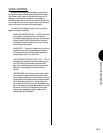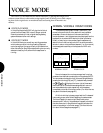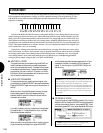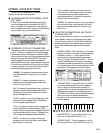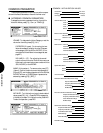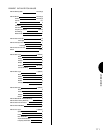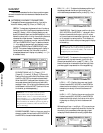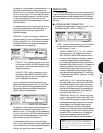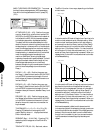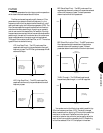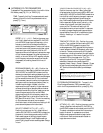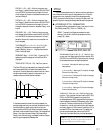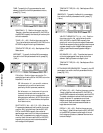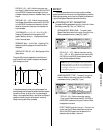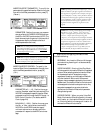
VOICE MODE
113
For example, in a two-element voice where element 1 is
a piano sound and element 2 is a strings sound, set
element 1 to Low = 1 and High = 100, and set element 2
to Low = 101 and High = 127. With these settings, soft
notes will play the piano (element 1) and strong notes
will play strings (element 2). If you want, you can
overlap the velocity limits of the elements, or use more
than two elements.
It is possible to set the low limit above the high limit. In
such a case, the element will be sounded by key-on
velocities outside the limits, ignoring the key-on
velocities in between.
NOTE LIMIT - To specify the range of notes that will
play each element, from within the Element parameters
function, press [F8] ( NtL ). (The black horizontal bar
in between the low and high fields provides a graphic
representation of the range setting.)
LOW (C-2 ~ G8) - Position the cursor over the left
field and use the JOG or INC/DEC to determine the
low note limit, which is the lowest note that will be
played by the element,.
HIGH (C-2 ~ G8) - Position the cursor over the
right field and use the JOG or INC/DEC to deter-
mine the high note limit, which is the highest note
that will be played by the element.
To play an element over the entire range of the key-
board, leave the note limits set at Low = C-2 and High =
G8. You can use the note limit parameters to create
keyboard split effects where different elements are
played by different keyboard areas.
For example, in a two-element voice where element 1 is
a bass sound and element 2 is a piano sound, set
element 1 to Low = C-2 and High = B2, and set element
2 to Low = C3 and High = G8. With these settings notes
below middle C will play bass (element 1) and notes
above middle C will play piano (element 2).
It is also possible to set the low limit above the high
limit. In such a case, the element will be played by notes
which lie above the low limit and notes which lie below
the high limit ignoring all notes in between.
AMPLITUDE
The Amplitude parameters function lets you determine the
output volume level and velocity sensitivity for each element, as
well as access the amplitude envelope generator (AEG) param-
eters, which determine how the volume of an element changes
over time.
● ACCESSING AMP PARAMETERS
To access the Amp parameters function, from within Voice
Edit Mode, press [F3] ( Amp ) or TRACK [11].
LEVEL - To specify velocity sensitivity and volume level
for each element, from within the Amp parameters
function, press [F7] ( Level ).
VELOCITY SENSITIVITY (-14 ~ +14) - Position
the cursor over the Vel offset field and use the
JOG, INC/DEC or the KEYPAD to determine how
the output level of the element changes in response
to velocity changes (keyboard dynamics) as you
play. Positive settings produce higher output level in
response to higher velocity values, i.e., the harder (or
faster) a key is played, the louder the sound. The
maximum setting produces the maximum level
variation in response to velocity changes. Negative
settings produce the opposite effect, i.e., lower level
in response to higher velocity. A setting of 0 results
in no level variation.
AMP LEVEL (0 ~ 127) - Position the cursor over
the Level offset field and use the JOG, INC/DEC or
the KEYPAD to determine the output level of each
element. (The black horizontal bar to the left of the
level value field displays a graphic representation of
the level setting of each element, which effectively
gives you a visual view of the mix .)
TEMPLATE TYPE (00 ~ 39) - Position the cursor
over the Type number field and use the JOG, INC/
DEC or the KEYPAD to select the type of amplitude
envelope generator (AEG)
template
, which gives you
instant access to the EG shapes of many popular
sounds. There are a wide variety of EG types to
choose from, including those from all major acoustic
and many electronic instruments. A setting of 00 is
the default EG for the preset voice. (To see a list of
the various template types, refer to the
W5/W7
Technical Information
booklet, provided separately.)
NOTE: The template type determines the maximum and
minimum range of velocity sensitivity and amplitude
level. Therefore, a velocity sensitivity or amplitude level
offset which exceeds the range of the template type will
have no effect.



